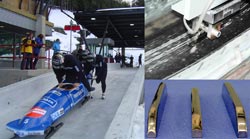Bobsled runs – fast and yet safe

The friction levels of runners can now be measured accurately: top right, the measuring setup with runner and sensor in the ice channel; below right, various types of runner: (left to right) bob, skeleton and luge. © Fraunhofer IWM<br>
Lightning fast, the sled bolts down the icy run. Will the team make it to the finish faster than their competitors? The tension in the crowd depends partly on the run itself: the faster the sleds can travel on the run, the more thrilling the race. But the track mustn’t be too fast: the crew still needs to be able to reach the bottom safely.
So engineers have to calculate and simulate exactly how fast a sled can travel on specific sections of the track. The calculations are based on the friction levels between the runners and the ice. Up to now, the problem has been the difficulty of measuring these levels at such high speeds, and the data collected have been rather far from reality. This meant that the speed of the sleds was often estimated too high or too low, which could lead to accidents.
In future tracks are set to become safer. Researchers at the Fraunhofer Institute for Mechanics of Materials IWM at the Microtribology Center µTC in Pfinztal have now developed a method of measuring the friction levels accurately. In so doing, they are able to provide their colleagues from Gurgel+Partner, consulting engineers responsible for design and construction of the bobsled track for the 2014 Winter Olympics in Sochi, with a solid basis for their calculations. “This measuring device allows us to ascertain the precise level of friction between the sled and the ice at high speeds – from which we can calculate the maximum speed a team can reach,” explains Prof. Dr. Matthias Scherge, business unit manager at the IWM.
Our “bobsled track” is in fact a large drum, similar to that of a washing machine, which is 3.8 meters in diameter and open on one side, situated in a bunker that has been chilled to -4°C. On the inside of the drum is a layer of ice, on which the test runners slide. A hydraulic cylinder presses each runner to the ice, simulating the weight of the sled and the crew. Whenever the drum rotates, the ice moves out from under the runner, slightly displacing both it and the attached friction force sensor. So instead of remaining at the lowest point, the runner is carried along a little by the rotating drum. Just how far depends on the amount of friction between the runner and the ice.
In their experiments with this apparatus and with other test rigs, the researchers take into account numerous factors, such as the nature of the ice itself. Ice at Whistler ski resort in Canada, for example, has different friction qualities than ice in Krasnaya Polyana near Sochi. Atmospheric humidity is significantly higher at Whistler because of its proximity to the Pacific, so ice accumulates faster there. The scientists can adjust the climatic conditions in the lab accordingly. They are also looking into the effect on runners of having a good finish. To what degree does a professional finish affect the speed of a bobsled weighing up to 630 kilograms?
Researchers also recreate the steering movements of the racing vehicle: the runners on the glide body can be set at an angle to simulate cornering. The minimal friction level – which is to say the fastest possible speed the sled can achieve on any particular track under various ice conditions, providing the team does everything right – is taken by Gurgel+Partner engineers as the basis for their calculations. In the meantime, construction is underway in Sochi.
Media Contact
All latest news from the category: Materials Sciences
Materials management deals with the research, development, manufacturing and processing of raw and industrial materials. Key aspects here are biological and medical issues, which play an increasingly important role in this field.
innovations-report offers in-depth articles related to the development and application of materials and the structure and properties of new materials.
Newest articles

Superradiant atoms could push the boundaries of how precisely time can be measured
Superradiant atoms can help us measure time more precisely than ever. In a new study, researchers from the University of Copenhagen present a new method for measuring the time interval,…

Ion thermoelectric conversion devices for near room temperature
The electrode sheet of the thermoelectric device consists of ionic hydrogel, which is sandwiched between the electrodes to form, and the Prussian blue on the electrode undergoes a redox reaction…

Zap Energy achieves 37-million-degree temperatures in a compact device
New publication reports record electron temperatures for a small-scale, sheared-flow-stabilized Z-pinch fusion device. In the nine decades since humans first produced fusion reactions, only a few fusion technologies have demonstrated…





















